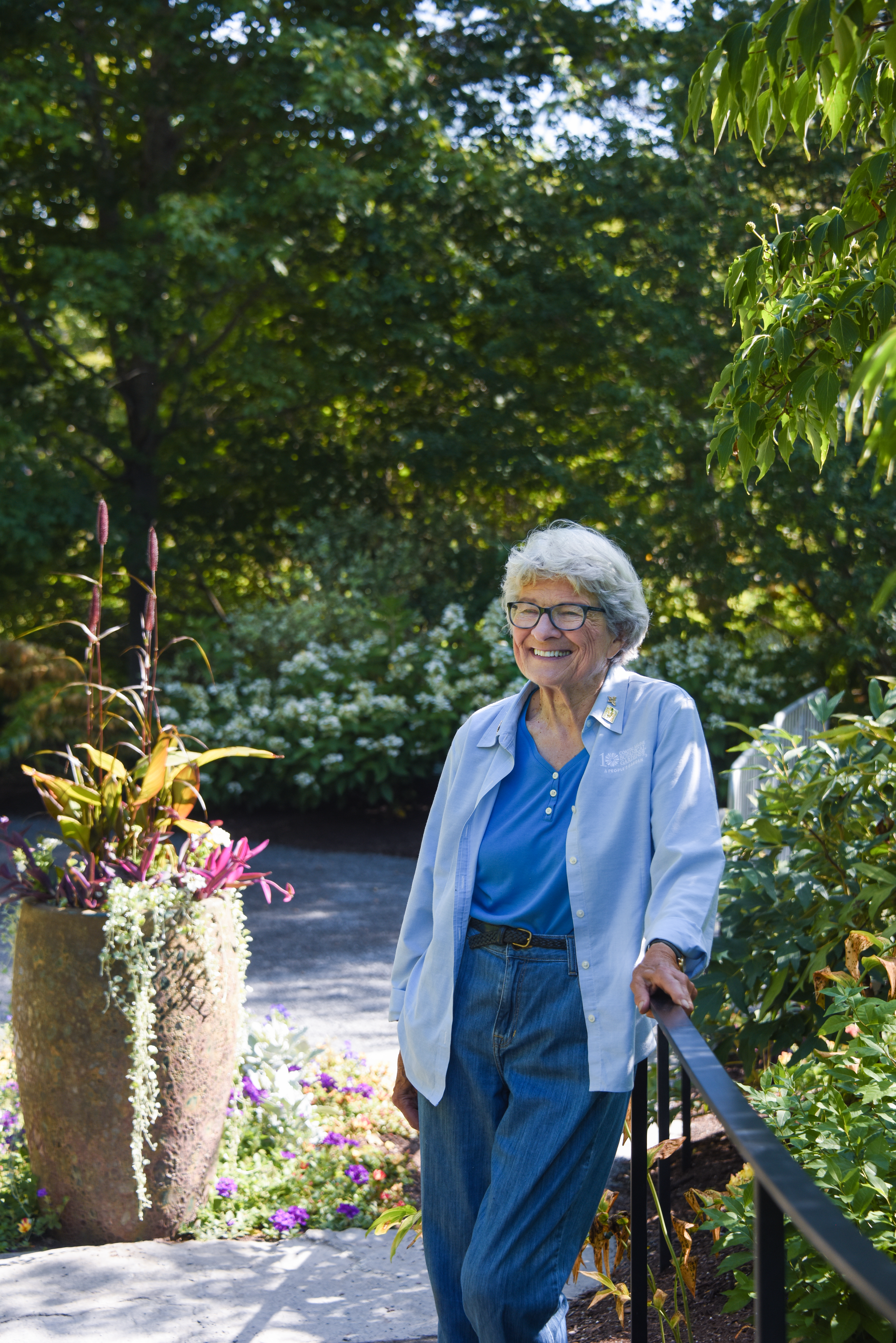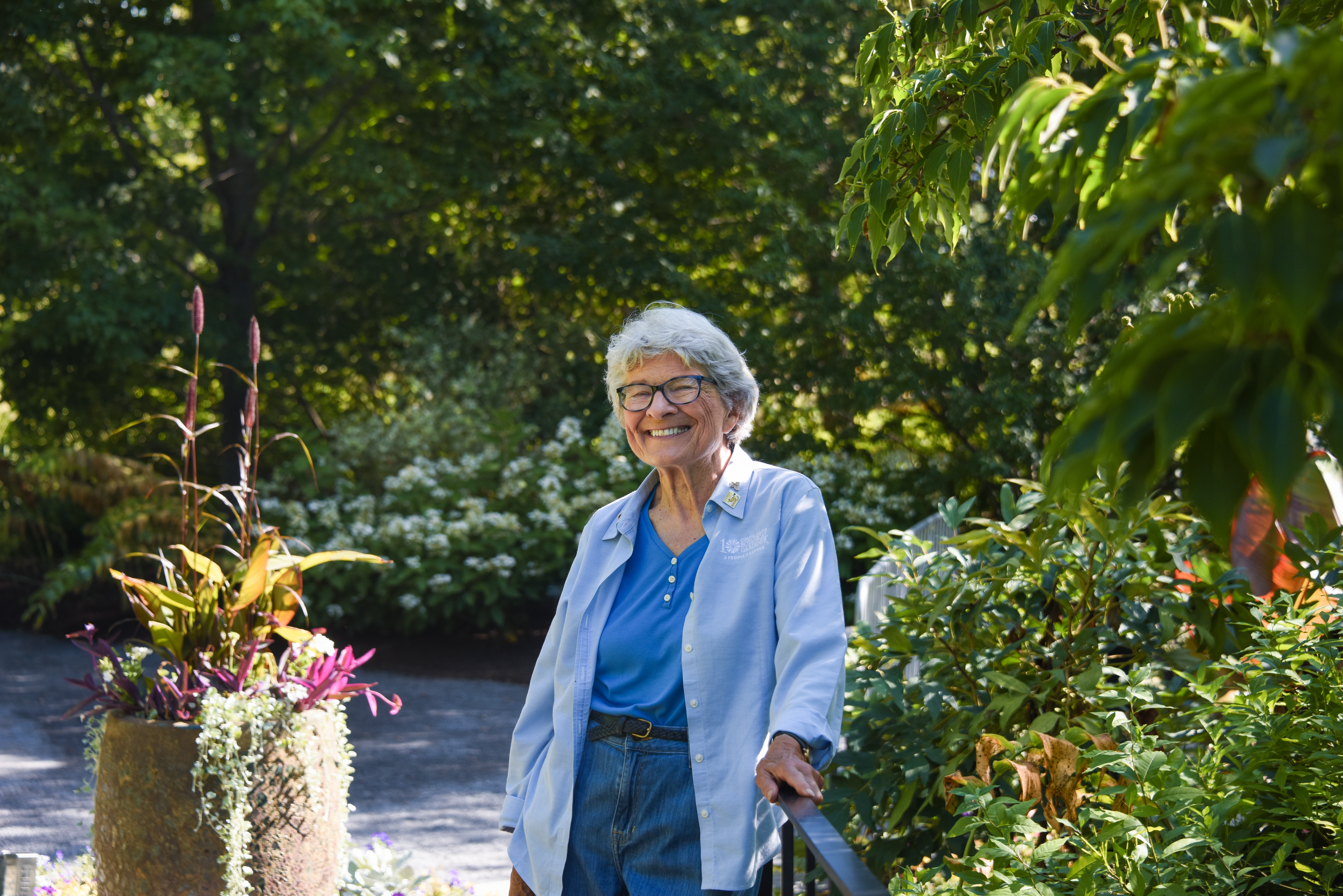The Heart of the Gardens
Talk to Us
BJ Dobson is not afraid of hard work. Although, to hear her tell it, her nearly 30-year docent career at the Gardens hasn’t felt much like work. With a CV covering everything from plant identification to helping lay the groundwork for the first docent training in 2006, dead-heading, manning the front desk, leading many (many) tours, volunteering in the gift shop, writing booklets and guides, brewing tea, stuffing envelopes, driving shuttles, serving as a Gardens’ ambassador, and working countless Gardens Aglow shifts, BJ has found a place in every department and with almost every staff member.
“She’s a legend,” says Amanda Russell, Manager of Guest Services. “BJ’s life has centered around the natural world, and our world at the Gardens is grateful to the gift of her time, which she bestows on us over and over again.”
“BJ is at the center of the Gardens,” says Jen McKane, Director of Philanthropy. “She’s been here longer and knows more than anyone.”
Though BJ spent her career as a registered nurse, “Not a day has gone by that I didn’t have a gardening or plant book open, reading and looking up information. If I can’t sleep, I read about plants. If it’s a day spent indoors, I read about plants,” she laughs.
 After moving to West Boothbay Harbor in 1991, BJ found herself working for Bob Boyd, one of the Gardens’ founders, at Boothbay Region Greenhouses. “It was supposed to be for two weeks, just to help get the annuals out. I ended up staying for 18 years before retiring to spend more time in my own gardens.” And more time at CMBG, which, thanks to the timing of that “two week” stint, let her in on the ground floor of project’s planning.
After moving to West Boothbay Harbor in 1991, BJ found herself working for Bob Boyd, one of the Gardens’ founders, at Boothbay Region Greenhouses. “It was supposed to be for two weeks, just to help get the annuals out. I ended up staying for 18 years before retiring to spend more time in my own gardens.” And more time at CMBG, which, thanks to the timing of that “two week” stint, let her in on the ground floor of project’s planning.
“That was just when that original group was looking a place for a botanical garden—we talked about it in the breakroom, looked at maps and surveys. Bob kept me informed, and I eventually became a charter member.”
What did that entail? “Oh, it was very glamorous,” BJ laughs, thinking back to one of her earliest tasks—Friday morning treks through the woods every week, April through October. She helped to record plant varieties, enter data into spreadsheets, and track plant growth. “I did that for two years. It could be pouring rain, or so hot you wouldn’t believe, fighting mosquitoes all the way—it didn’t matter. You were out there.” That research was compiled into two publications, A Guide to the Native and Naturalized Vascular Flora of Coastal Maine Botanical Gardens and the Gardens’ Plant Checklist.
It wasn’t just behind-the-scenes work, either. “We used to have a lot of fun, raising money for the Gardens, staying here until midnight, cleaning up after events—sometimes even during a torrential downpour. One year,” she adds, “I remember dead-heading hundreds of daffodils in the Rhododendron Garden after work for several evenings so it would look nice for a weekend event. Oh, and the plant sale—I really enjoyed doing that. Now that was a lot of work!”
In her easy and understated manner, BJ glosses over the fact that she was Chair of the Gardens’ first seven plant sales, a title that came with the task of ordering, pricing, setting up the event, and selling the plants.
“It was fun for me, though—I always had such a big interest in plants, and I know most of the botanical names,” a feat that can be attributed to her love for nature, natural tenacity, and a curious mind.
But it was a trip to Wyoming to visit one of her four sons that initiated the love for Latin names. “I went on a birding walk up into the hills of Jackson. One of the people on the trip was the town manager, and she and I got sidetracked, looking at wildflowers. She knew the botanical names of every plant,” BJ recalls. “Her grandmother in Poland shared it with this woman’s mother, who shared it with her. I remember thinking, ‘I could learn those names, too,’” BJ says. “And so I did.”
That specialized knowledge has seen her though countless guided tours, docent trainings, plant sales, and the identifying and organizing of miscellaneous slides of plants growing at the Gardens—plants she knows well. “I was in the first docent training class in 2005—two hours every week for most of the summer,” time spent learning all the plants—names and stories—growing along the newly created paths. “There were no formal gardens then,” BJ adds, “just wonderful woodland plants that we learned so much about.
“But that’s what’s so special about this place—it’s our history and our dedication,” she says. “It’s taught us that you can carve something like this alongside a forest like we did.”
This year, in the wake of a global pandemic, that lesson is more poignant than ever.
“I’m so grateful we were able to open this year, especially during a difficult time when people have been inside for months, all winter long. They come here and come alive—people who can’t travel anywhere else can come here,” BJ says.
“I always ask people where they’re from,” she adds, “and this year, so many people are from Maine—here for the first time! But everyone says they’ll be back—they just can’t believe this has been in their backyard, and, though they knew of the Gardens, they had just never made it here until now.”
That’s the magic of this small piece of the coast, according to BJ, and that’s why she’s not only a docent, but a member, donor, and participant in the Perennial Society, too—a group of donors who have elected to include CMBG in their estate plans. “Private donations are so important to the Gardens. So much goes on here, and all of that costs so much—it makes you feel good to contribute whatever you can to make the Gardens successful,” she says.
“For those thinking of becoming donors, I want to tell them that we have people visiting here, not only from every state, but from all over the world—that’s how special it is,” she continues. “I’d also make sure they had a tour to see where we’ve been, what’s here, and where we’re going. I mean, we pulled it off!” BJ laughs. “I remember opening day in 2007, wondering if we’d be able to do enough, make enough money to continue, attract enough people. A thousand people came that day, and that summer, our visitor numbers were more than what we’d hoped to see in ten years’ time!”
Planned giving means that this remarkable history won’t be lost, that the Gardens’ legacy will continue. “Gifts like BJ’s will make sure we’re here in a hundred years,” says Jen McKane. “It means giving further, joining the heart of the Gardens.”
“I love my time here,” says BJ. “I feel part of everything—we volunteers and docents, we feel so valued. I couldn’t live without plants,” she adds. “I wake up with gardens, and I close my day with gardens.”
Two of BJ’s Favorite Garden Quotes:
“Touch the earth, love the earth, honour the earth, her plains, her valleys, her hills, and her seas; rest your spirit in her solitary places.” ~Henry Beston, The Outermost House: A Year of Life on the Great Beach of Cape Cod
Words of Wisdom
If all insects were to die, nothing else would live.
If all greenery were to die, all else would die.
If all four-legged creatures were to die, all else would die.
If all creatures with wings were to die, all else would die.
If all humans were to die, all else would survive.


